The Kiss by Gustav Klimt (Baumgarten, 1862 - Vienna, 1918) is one of the most famous kisses in the history of international art: preserved in Vienna, in the Österreichische Galerie Belvedere, more precisely in the collections of the Upper Belvedere, it depicts a couple in love on a flowery meadow and all around nothingness, to better represent the triumph of universal love. The two hold each other in a tender embrace, united by a strong and deep feeling of love and protection, which nothing and no one will ever be able to break. He is standing and wrapping his golden mosaic tunic around the maiden; he has his head reclined to kiss her gently on the cheek, while with his hands he supports her head and face. She is kneeling on the grass and is therefore lower than the man; she literally surrenders to the warm embrace, keeping her eyes closed and her head back and clutching her lover’s body, to become one with him. With one arm she encircles his neck, her other hand seeks his hand and then rests on it: what Klimt depicts is a true love idyll, where two almost ethereal souls become one. Contributing to this feeling of enveloping sentiment are certainly the long, gold-colored robes of both (Klimt painted the Kiss at the height of his “golden period” undoubtedly influenced by the Byzantine mosaics the artist had occasion to admire in Ravenna), although they can be distinguished from each other because of the different decorations: the man’s is characterized by geometric elements with a mainly rectangular shape and colors ranging from black, to gray, to white; the woman’s is characterized by floral elements, which seem to be ascended from the flowery meadow on which they both rest, and by circular and spiral shapes. The unique figure of the two lovers also stands out against a golden background that creates an abstract and timeless place.
The two have not been precisely identified, but many scholars and art historians agree that the kneeling female figure is Emilie Flöge (Vienna, 1874 - 1952), Klimt’s muse and close friend (or perhaps more). The painting was made by the celebrated Austrian artist in 1908, five years after his 1903 stay in Ravenna, and, as already stated, the inspiration drawn from the Byzantine mosaics of the city’s great monuments is clearly evident from the extensive use of gold leaf applied to the canvas. The flowery meadow on which the couple stands could presumably be the shore of the Attersee Lake in front of the Villa Oleander in Kammer am Attersee (the seaweed at the woman’s ankles is also visible), and the golden background could perhaps be the very mirror of the Attersee water, on which the morning sun and moonlight are reflected, in front of which Gustav and Emilie indulge in each other. Indeed, from 1900 to 1916, the two spent their summer vacations in Litzlberg am Attersee, on the Attersee lake, in the Paulick villa in Seewalchen, the Oleander villa in Kammer or the Forsthaus in Weißenbach. Evidence of this are the numerous shots in which Emilie is depicted in her avant-garde clothes and the more than forty landscape paintings the artist executed in these places.
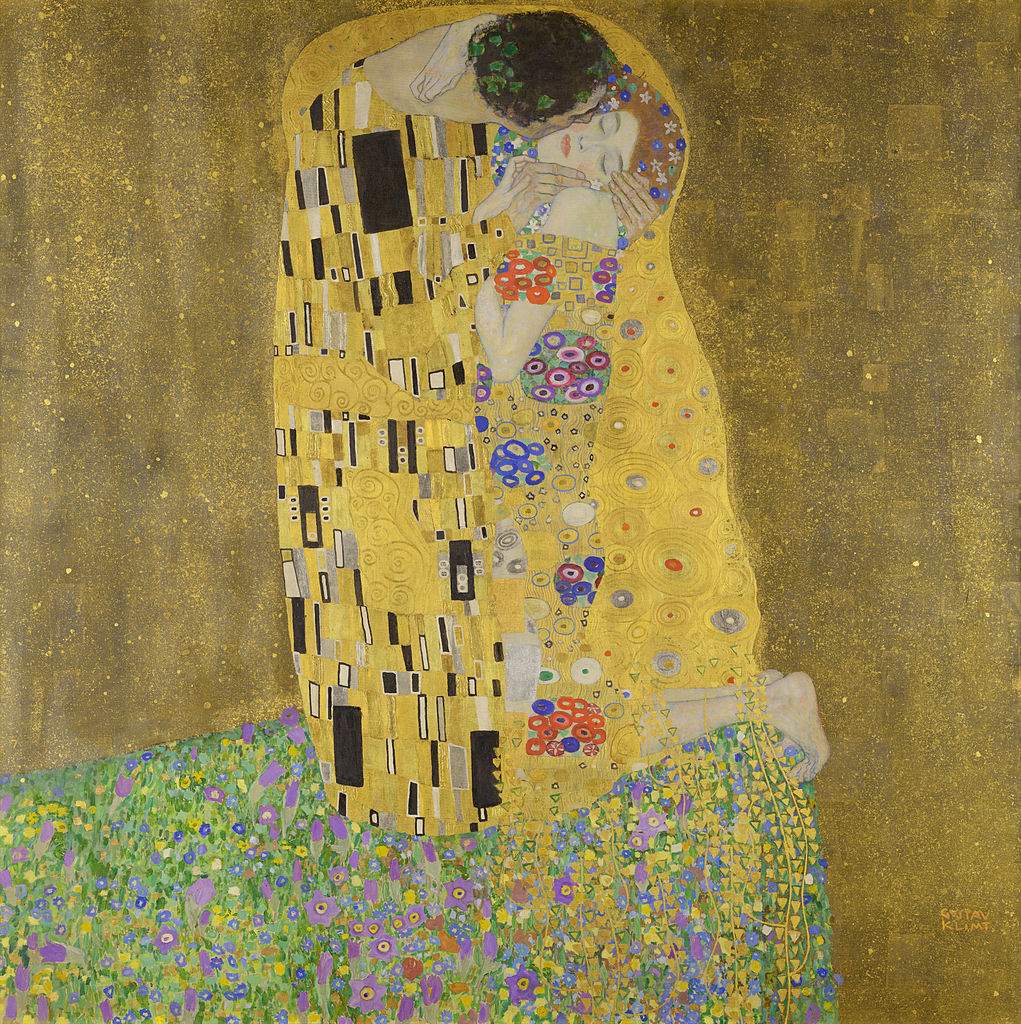 |
| Gustav Klimt, The Kiss (1907-1908; oil on canvas, 180 x 180 cm; Vienna, �?sterreichische Galerie Belvedere) |
Gustav Klimt had a reputation as a womanizer; he never entered into marriage with any of his women and had at least sixteen children by his mistresses, but his bond with Emilie Flöge was the most enduring and sincere emotional relationship he had with a woman: it lasted a full twenty-seven years and was probably not only friendship, but also love. The two were inseparable and respected and supported each other in business as well: in addition to being Klimt’s muse, Emilie was a truly successful businesswoman of the time, in the field of fashion; she loved Gustav’s painting very much and liked to be a protagonist of his art, he was fascinated by Emilie’s resourcefulness and her revolutionary style.
The last of four children, Emilie Flöge was born in 1874 in Vienna to a woodcarver who specialized in making pipes, which most men smoked in those years. She was a member of Viennese bohemian circles and thus took an active part in the cultural and social life of late nineteenth-century Vienna, but above all she was a fashion designer of great renown, both for her skills and for the innovative turn she brought to fashion, which was quite unconventional for the time. With her sisters Pauline and Helene, she founded the fashion salon Schwestern Fl öge(Flöge Sisters) in 1904 in Vienna, in the Little House at Mariahilfer Strasse 1b: a haute couture atelier in which up to eighty seamstresses worked and which was frequented by the Viennese upper middle class. The interior of the atelier was designed by Josef Hoffmann and Koloman Moser in the Wiener Werkstätte style. The latter was an art movement founded in 1903 by architect Hoffmann and graphic designer and painter Moser, under the patronage of industrialist Fritz Waerndorfer, modeled after the English and Scottish Arts and Crafts movements. Their goal was to introduce objects of high aesthetic and artistic value into everyday life as well: in fact, the founders conceived design as a synthesis of art and craftsmanship realized in everyday life, and their movement, active until 1932, was based on the principle of thetotal work of art, the Gesamtkunstwerk: the very concept of art was redefined to bring artistic craftsmanship back to the forefront, thus beginning to produce, in line with these principles, high-quality objects in the sphere of everyday life, such as furniture, porcelain, glass, jewelry and fashion.
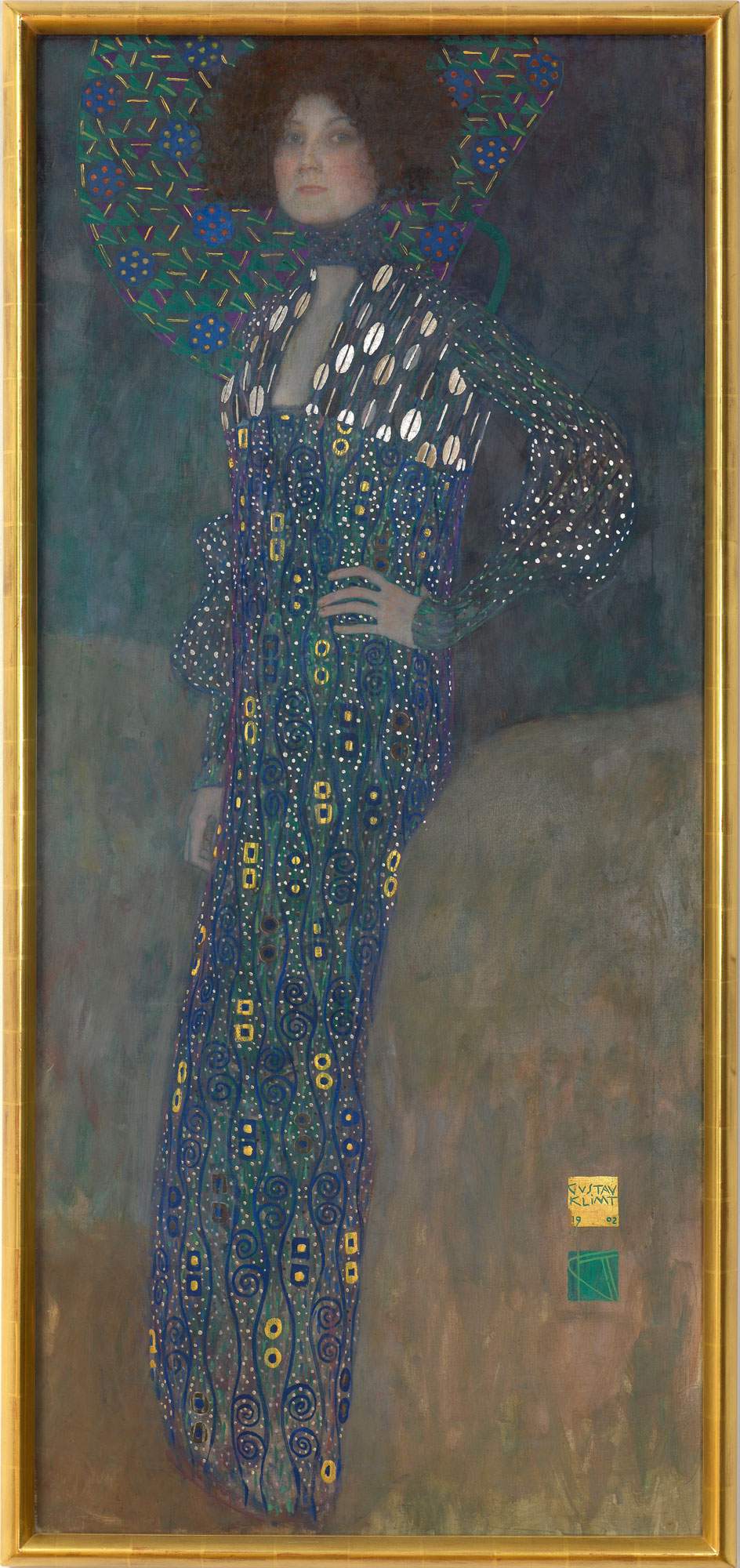 |
| Gustav Klimt, Emilie Flöge (1902; oil on canvas, 178 x 80 cm; Vienna, Wien Museum) |
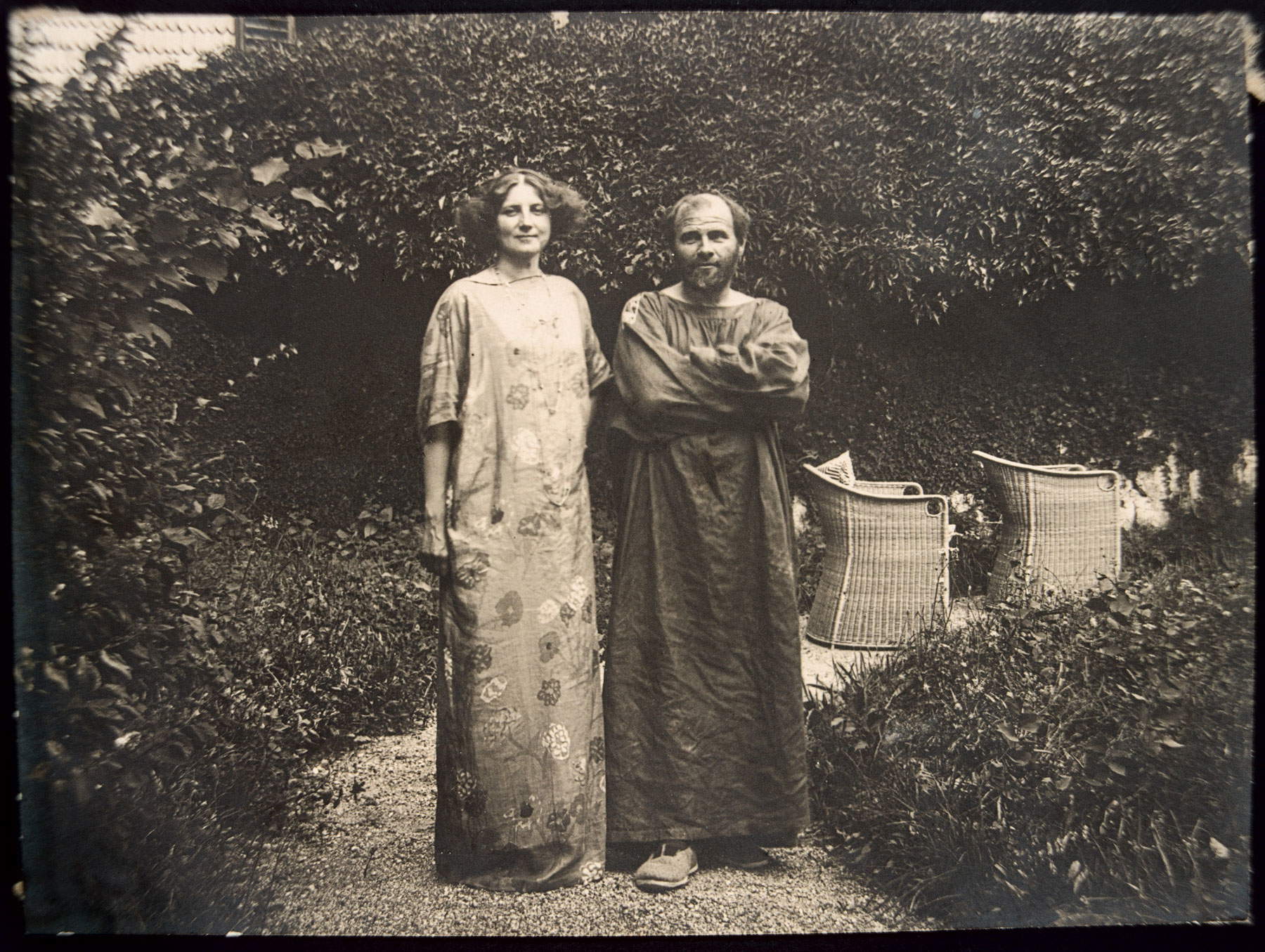 |
| Emilie Flöge and Gustav Klimt ©Klimt Foundation,Vienna |
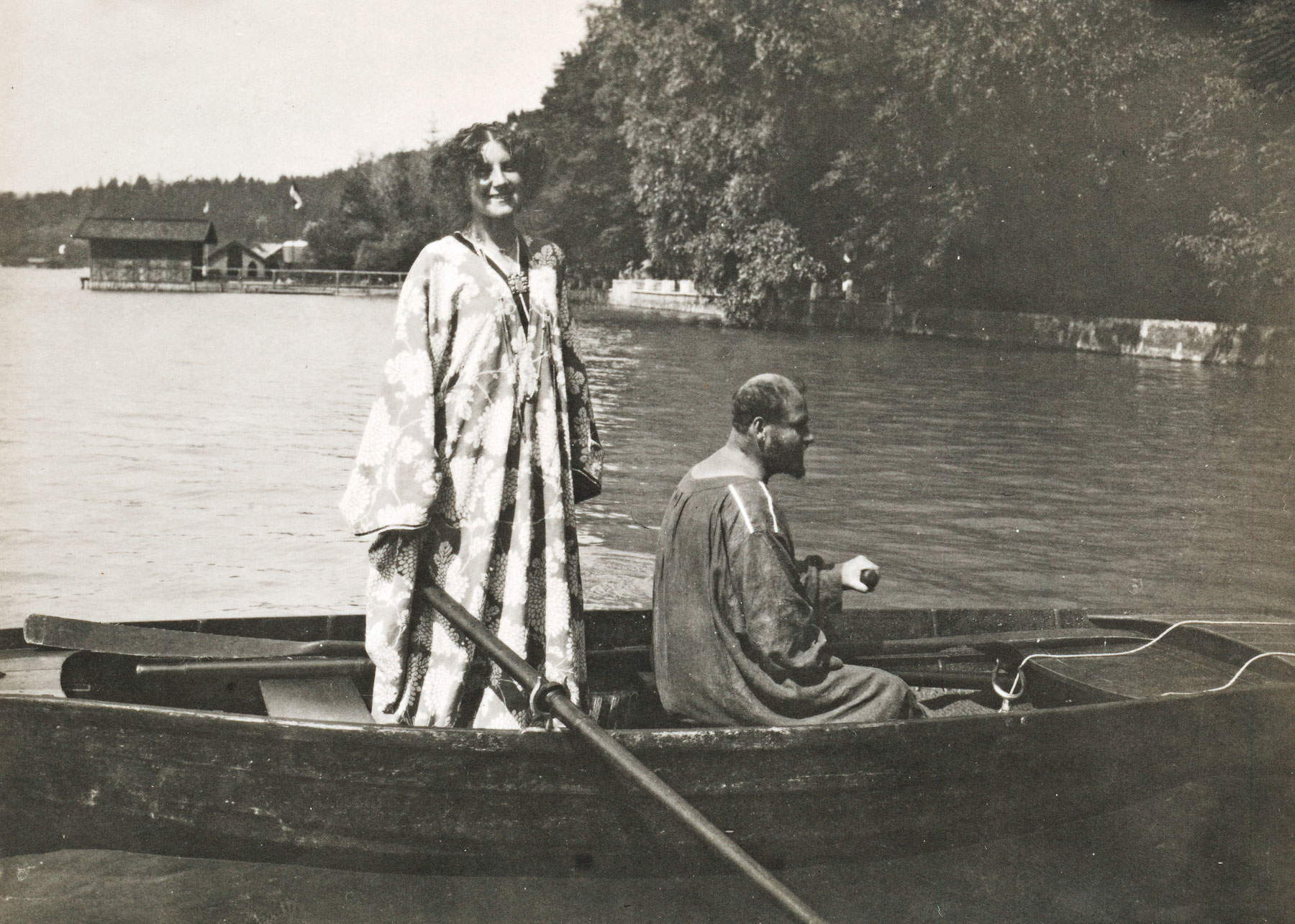 |
| Emilie Flöge and Gustav Klimt photographed by Emma Bacher (1909) ©Klimt Foundation, Vienna |
 |
| Emilie, Hermine and Pauline Flöge, Gustav Klimt and Hermann Flöge in a boat on the Attersee photographed by Emma Bacher (1905) ©Klimt Foundation,Vienna |
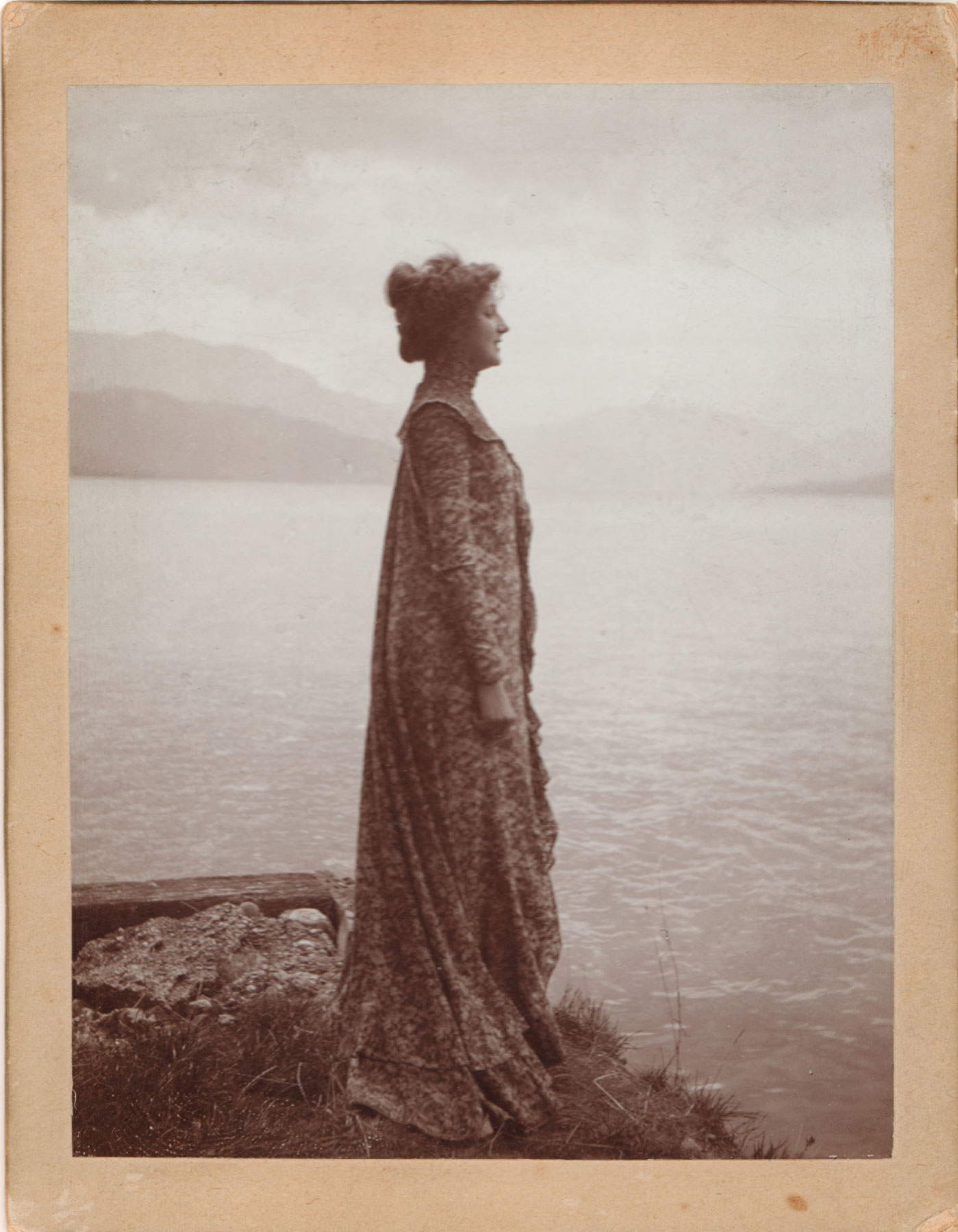 |
| Emilie Flöge photographed by Klimt (1906) ©Klimt Foundation, Vienna |
The Flöge sisters’ atelier very soon became a successful business, frequented mainly by wealthy women who loved modernity in all its forms. A painting completed by Klimt in 1902 and now housed in the Wien Museum depicts 28-year-old Emilie Flöge in a dress typical of her revolutionary fashion, the so-called Reformkleid, which moved away from the conventional fashion of the time of tight corsets on the body to delineate the form. Her dresses were therefore defined as reformed, characterized by comfortable and soft shapes, mainly long, colorful and decorated with floral prints and geometric elements. Flöge’s reformed style therefore intended to liberate women from the constraints of the corset and through clothing to make women braver and more independent, as she herself was. Emilie, too, in fact, as evidenced by photos and pictorial portraits, wore floor-length, soft, ornately patterned dresses, which she often accompanied with brooches and necklaces from the Wiener Werkstätte, becoming a model of her style herself. To keep abreast of the latest fashion trends, Emilie regularly traveled to Paris, the realm ofhaute couture, to bring the latest fashions to Vienna and to create clothes that were always on the cutting edge.
Gustav and Emilie met on a special occasion: Helene, Emilie’s older sister, married Ernst Klimt, the painter’s brother, in 1892; Gustav then began frequenting the Flöge family home often, even spending summer time with the latter at Lake Attersee, and growing closer to Emilie. There is extensive correspondence between the two and numerous postcards sent by Klimt to Emilie, as well as photographs of excursions and summer vacations spent together.
When Klimt died in 1918, part of his estate went to her; the Schwestern Flöge atelier continued to operate until 1938, when it was forced to close after the Austrian Anschluss to Nazi Germany. Emilie never married and disappeared in Vienna in 1952. She was buried in the Protestant cemetery in Vienna-Simmering and fell into oblivion unlike Gustav Klimt who became immortal for his artistic masterpieces. It was a British researcher passionate about the revolutionary figure of the fashion designer who rediscovered Flöge’s tomb in 2006, kicking off a reconsideration of the too-long-forgotten tomb. In her lifetime, Emilie Flöge was one of the most successful fashion designers, capable of bringing a wave of sophistication, freshness and boldness to the fashion of the time and spreading modernity and emancipation to the women of Viennese high society. And for that merit she should be remembered.
To learn about Emilie Flöge through the places she frequented, visit the official website austria.info
Warning: the translation into English of the original Italian article was created using automatic tools. We undertake to review all articles, but we do not guarantee the total absence of inaccuracies in the translation due to the program. You can find the original by clicking on the ITA button. If you find any mistake,please contact us.